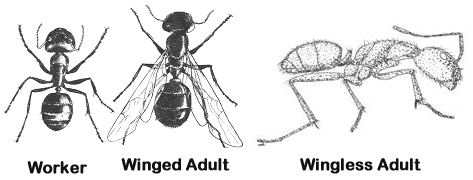Carpenter Ants

Carpenter ants occur widely in the United States and are the largest of our common ants. The adults vary in length from about ¼ inch for the worker up to ¾ for the queen. They are either entirely black or black and orange-red. A number of different ants utilize cavities in wood as nesting sites; however, only those of the camponotus genus are actually carpenter ants.
To establish their nest, carpenter ants seek soft, moist, wood, particularly wood that has weathered and begun to decay, but will nest in solid wood.
The nest can be found in columns, roofs, sills, trees, stumps, scrap wood, insulation,
Voids in wood and non-wood products.
These ants do not eat the wood but excavate galleries in it to rear there young. Carpenter ants eject course sawdust along with the remains of their dead and the leftovers from their meals, mainly insect parts. Finding this is a good indication of activity.
The work of the carpenter ant is easily distinguished from that of termites. Their galleries are excavated with the grain and follow the soft portions of the wood. The galleries are smooth and clean. Termite Galleries however will generally contain soil and or packed sawdust like materials, and are not smooth and clean.
Even if the ants are found in the structure does not determine the colony is in the structure. A careful inspection must be made to determine the location and the proper method of eliminating the colony.
Powder Post Beetles

Powder post beetles covers three kinds of beetles:
1. Anobiid beetles : attack almost any kind of wood but seem to prefer old wood
2. Bostrichid beetles: prefer the sapwood of most hardwoods.
3. Lyctid beetles: infest the sapwood of hardwoos, newly seasoned wood, (lumberyards, new hardwood floors, tool handles.)
Damage: small round holes with sawed or rounded edges. May be numerous, especially on sapwood portions. Holes are connected to tunnels filled with coarse to powdery sawdust. Sawdust may fall from holes if wood is jarred, or may be pushed out by adults when they emerge.
If you see any of these signs or want an inspection to be sure you are not infested with this pest, please call or e-mail.
Old House Borer (Wood Borer)

Old house borers are in the large family of long horned beetles. Adults are elongated (1/2 to 1 inch long) and black. Gray hairs and markings on the thorax and wings. The larva is elongated (1 inch when mature) and slightly flattened.
Damage: large oval holes that connect to tunnels that deeply riddle coniferous sapwood. The tunnels are filled with fine loose powder that may fall from holes at the surface.
The adults emerge in the spring and summer to mate. The female can lay up to 150-500eggs on the wood and may hatch in one to two weeks. They will bore into the wood and start the process all over again.
The term old house borer may give the impression these insects are a pest of old structures. In fact most of the infestations are found in new structures.
If you find evidence of pest, or would like your property inspected, give us a call or e-mail.